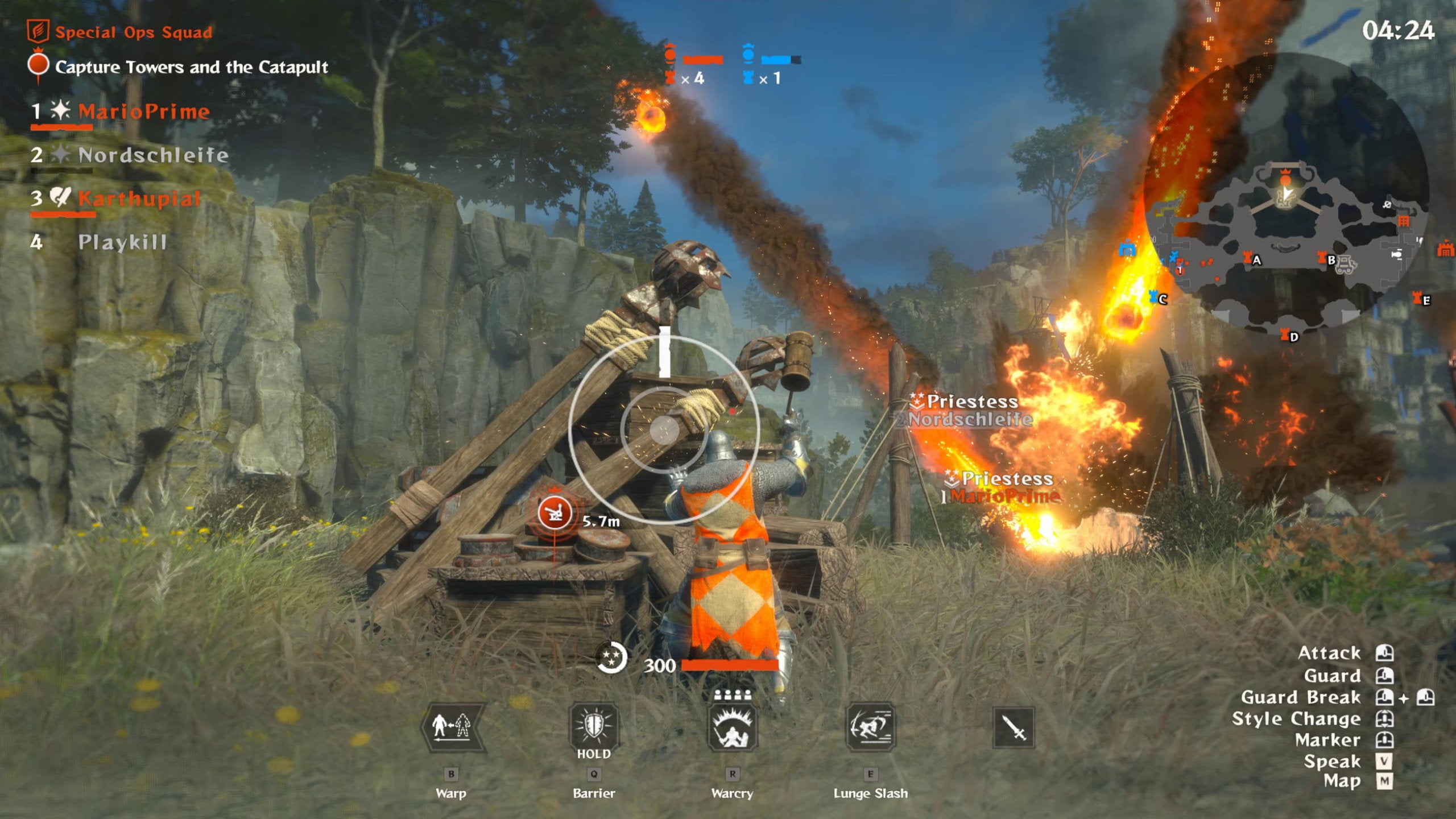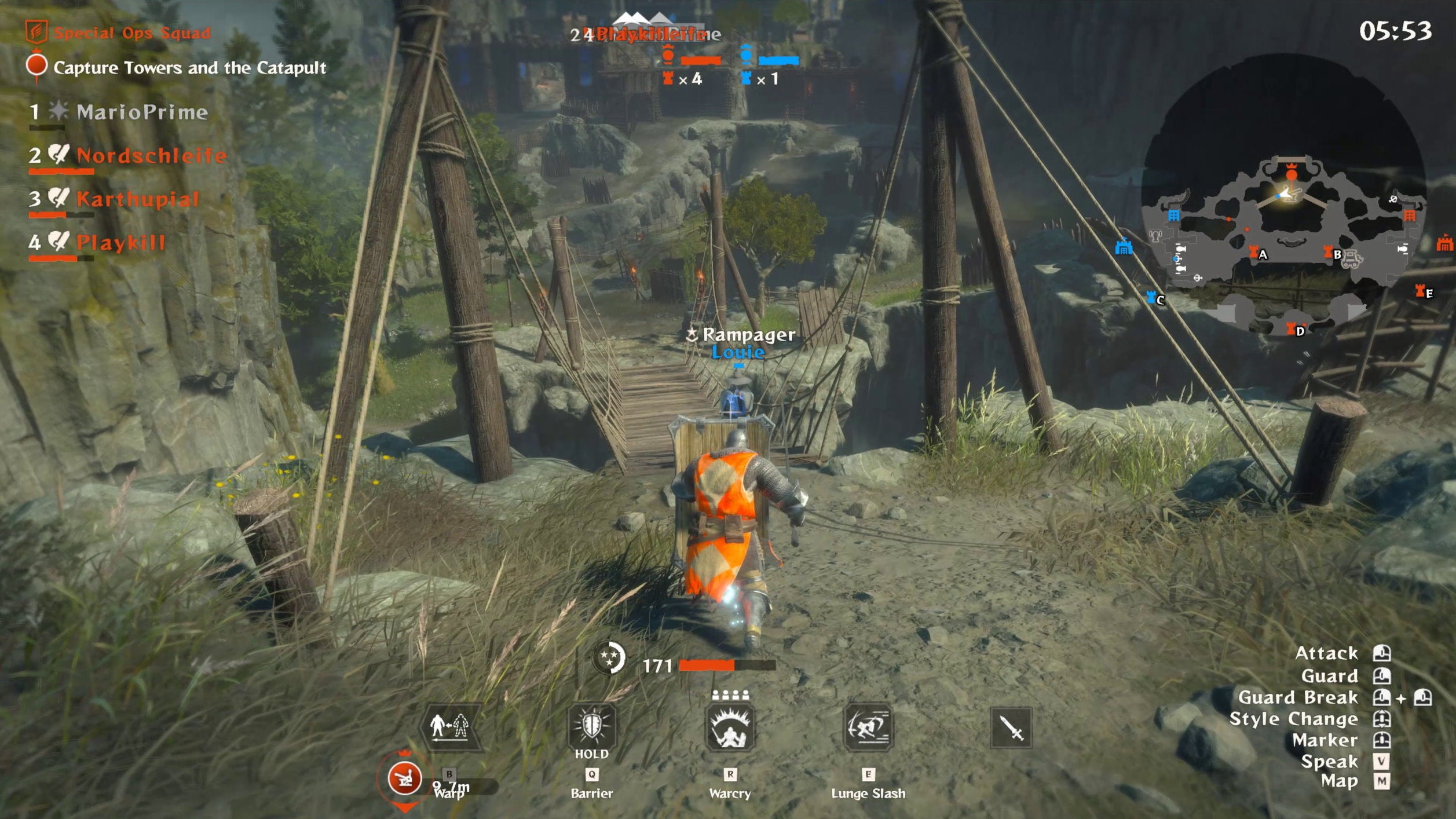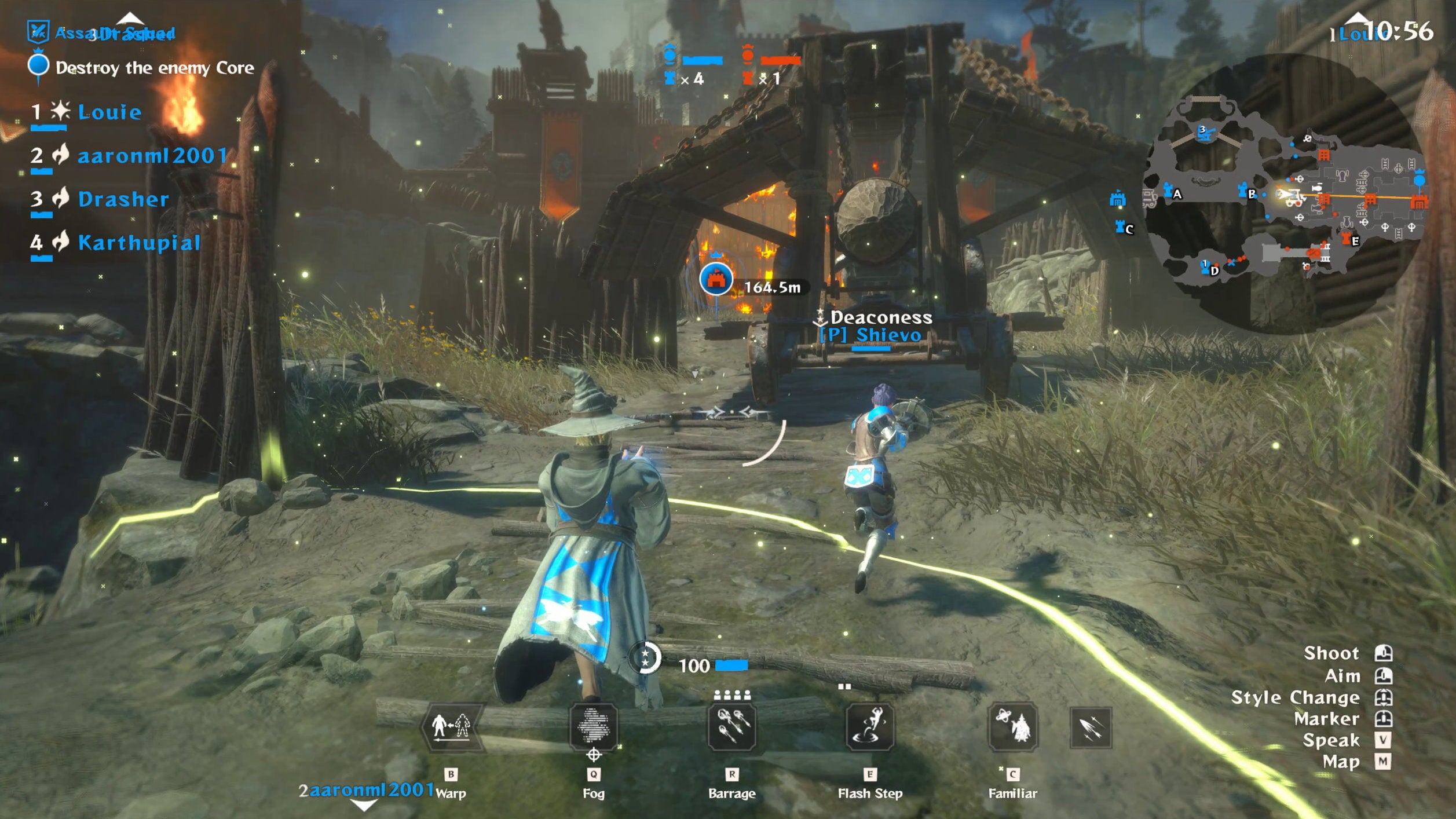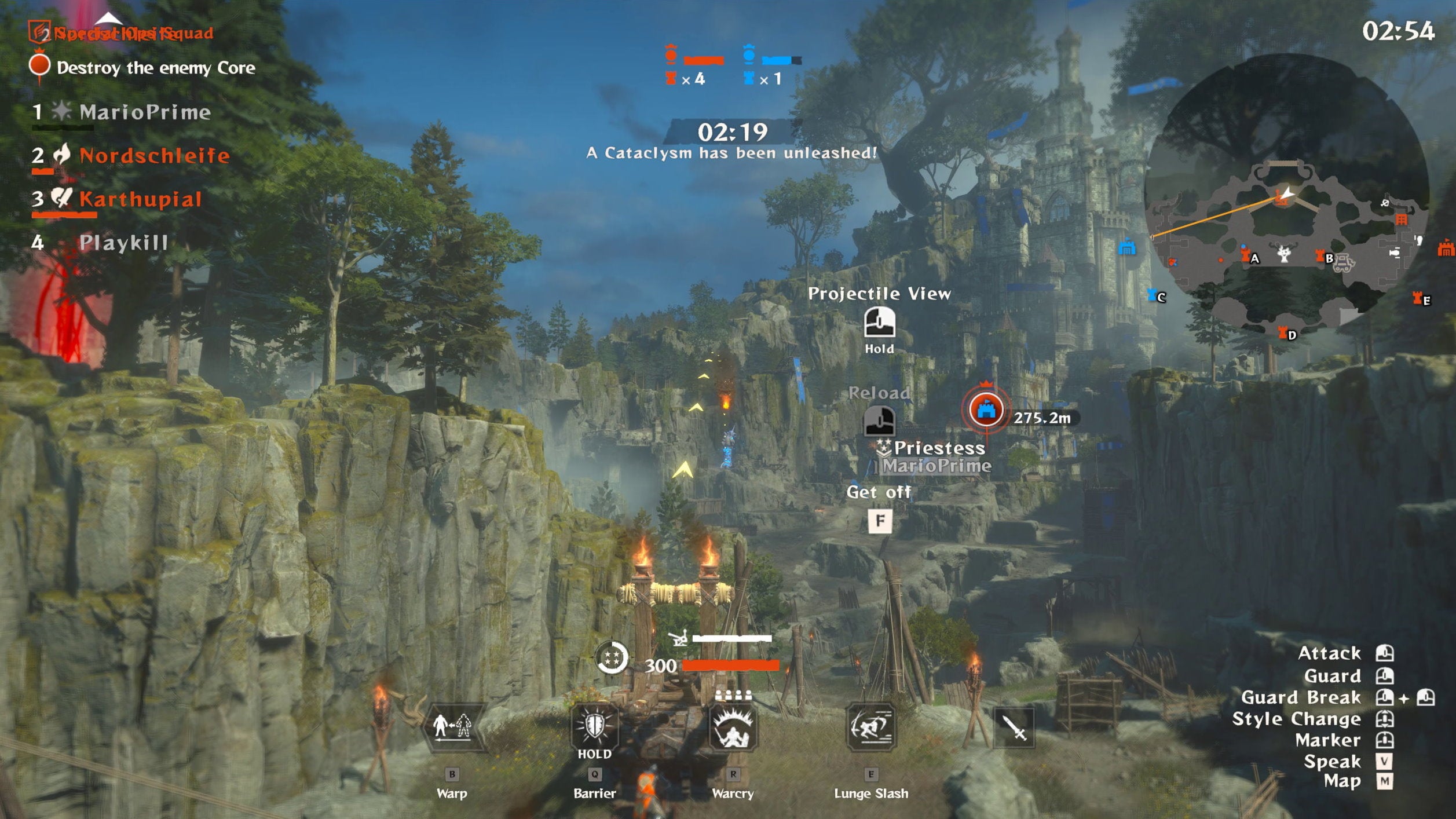I played the 2-Army Battle mode in my preview session that saw two teams of 20 players try and destroy each other’s respective bases. There’s also a 5-Army Battle mode that I didn’t get to see during my session, but this will have up to 100 players all duking it out on the same map. For the 2-Army mode, however, each castle was located at either end of the battlefield, giving Warlander the air of a MOBA as seen from the ground. Spawn point towers and destructible bridges, fortifications and more were all located along various lanes on the way toward the enemy keep, and you’ll need to capture and defend these to hold and push your advantage over the course of the match.
You’re not just a cog in large, amorphous army, however. In the 2-Army mode, each team was split into five squads of four, and before the match kicked off properly, we all had to vote on what our overall strategy was going to be (Assault, Balanced or Defensive), and what respective roles we were all going to play in the battle ahead. The former determines the makeup of the latter, with Assault Tactics prioritising offensive squads over defence and tower and catapult-building special ops teams, for example, while Balanced Tactics gives you, as the name implies, a roughly even spread of all three.
There’s also a specific Commander role, which players can nominate themselves for during the pre-match build-up. They have a specific set of tools available to them to help guide their team to victory, and can assign specific objectives to certain squads in addition to playing on the battlefield itself. In the 5-Army mode, Commanders will also have access to ‘Diplomacy Cards’, according to publishers Plaion, that will let them create alliances with other teams for limited amounts of time.
In our 2-Army session, though, I’m not sure any of us really paid much attention to our respective roles – hence why I was building a catapult on my lonesome. But your fellow squad mates are all numbered the map, letting you easily pick them out from the rest of the team if you lose track of them. Once towers are captured, you can spawn from these on death, or warp to them mid-battle if your commander needs you elsewhere.
There were three types of warrior to choose from in our session – your big beefy warrior, healing cleric and magic-hurling mage – and you can pick a new one to take into the match each time you die and respawn. Technically, you have five characters to choose from in a match, as each player has their own individual ‘deck’ to fill with the warriors of their choice. You could bring one warrior and four very different types of cleric depending on your playstyle, for example, or have a more balanced team to draw from instead. Each warrior you play will earn their own individual XP that goes toward improving their Valor rank, which in turn will earn them different titles over time that bring with them various different stat boots to equip, and a larger pool of ‘CP’ points you can just to equip better armour and abilities.
I like the idea of bringing up your own team within this wider multiplayer skirmish, although the ease with which you’re able to level them all up and create a squad you like will no doubt be the line where Warlander lives and dies. Your higher tier characters, for example, can’t be used immediately when you go into battle - you have to earn enough valor in-game as well before you can select them from your deck. You can do this by taking towers, building defences, healing allies or defeating enemy soldiers, which I suppose is designed to give you an incentive to participate in your team objectives before bringing out the big guns. However, they also have longer cooldown periods before you can select them again if they die, so a mix of low-level characters you can play immediately and beefier ones to pull out in times of need is likely going to be critical for a successful deck.
In some ways, I’m hopeful this means that newcomers won’t be instantly one-shotted by more experienced players they come across online - as often happens in multiplayer shooters and the like. Plus, despite being free-to-play, Plaion have insisted that its microtransactions will be limited to cosmetics only, which should help level the playing field further.
“It will have multiple tiers of battle pass to start,” Plaion told us during our session. “We will have a free version, we will have, for lack of a better word, a ’normal’ version, and then we will have an elite version, which will allow you to spend a little bit more money and get some extra stuff out of that. We’re also going to have bundles and things like that in the game. There is a lot of character customisation options when you go into the avatar [screen], for example, when it comes to paints, emblems, and of course emotes. These will all be stuff that will be expanded over time and potentially available in the shop to purchase. We are very strongly against pay to win, so our plan is to have cosmetic enhancements and improvements be what you are able to spend money on.”
After battles, you do earn bits of loot that you can then equip on your favourite warriors, but the sheer breadth of available slots in the customisation menus here was daunting, to say the least. I counted six different basic equipment slots – all of which can have their looks altered using the in-game currency – as well as two different drop-downs for Weapon and Skills, and another for Traits. Maintaining all this across five characters could be a tall order when each fight only plopped out a maximum of three rewards for me after a resounding victory. In my second fight – which our team also won – I only got one reward. That feels a pretty stingy for a 15-minute fight, although I must say the moment-to-moment brawling was pretty fun and diverting when I was right in the thick of it. While the combat wasn’t nearly as nuanced as the hacking and slashing in Toylogic’s Nier: Replicant, my frantic mouse and keyboard clicks still resulted in some satisfyingly flashy attacks to keep things interesting.
I can see Warlander being a good game to squad up with a bunch of pals with – assuming you’ve got a commander who knows what they’re doing, as we did in our Plaion-led session – but it’s also going to face the same challenge that every large multiplayer game is going through right now, and that’s ‘Do I have the gosh-darned time to invest in yet another chuffing multiplayer game?’
To see if Warlander ticks your respective multiplayer boxes, you can join in its open beta over on Steam starting today. I will be watching with cautious interest from the sidelines.





